
The Mahavidyas are ten powerful forms of the goddess Mahakali. Each of the Mahavidyas represents a different aspect of the divine feminine energy. Their worship is often based on Tantric practices, involving mantras, visualizations, and rituals. These practices are believed to awaken inner power, achieve desires, and ultimately lead to liberation (moksha). Each Mahavidya offers specific qualities – Tara removes obstacles, Tripura Sundari imparts knowledge and liberation, Bhairavi conquers negativity, Bagulamukhi helps defeat and conquer enemies and so on. The list of ten Mahavidyas include the following:
Kali- The Goddess who destroys the evil and defends the innocent
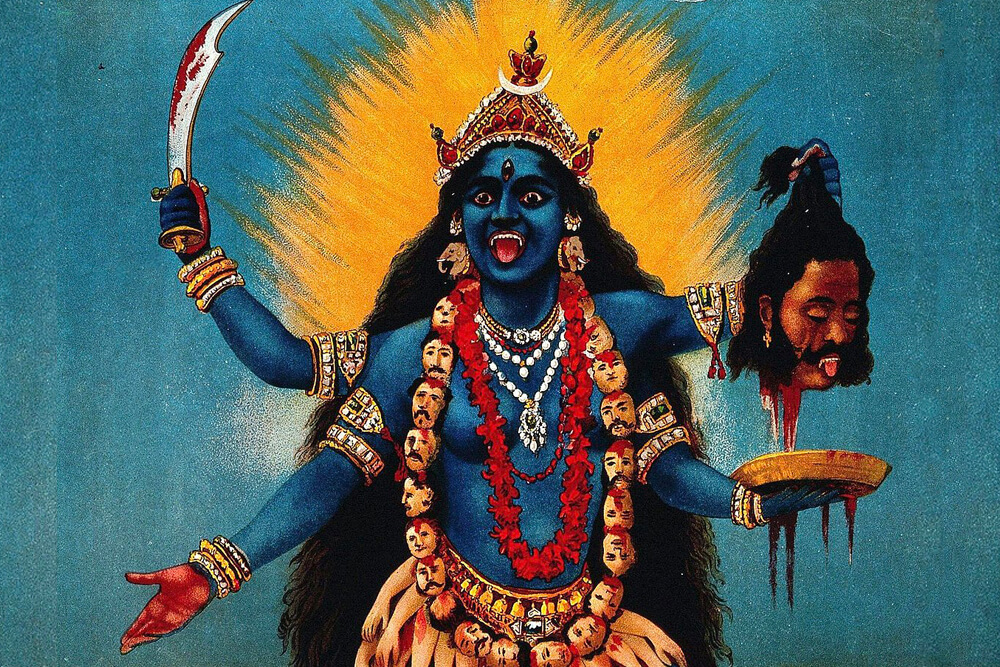
Kali also called Kali Mata (“the dark mother”) is the first of the ten Mahavidyas. She is worshipped as a warrior goddess who destroys evil forces and mother goddess who defends the innocent. She is also seen as the divine protector and the one who bestows moksha, or liberation. She is typically depicted with dark skin, and a garland of skulls. She is often depicted as a fierce and powerful figure, symbolizing both destruction and creation. She stands on the body of Shiva, her consort, symbolizing her dominance over earthly attachments. She is sometimes shown engaged in a dance of destruction, which represents the eternal cycle of creation, preservation, and destruction. She is usually shown with multiple arms, each holding a weapon or a symbol. Her fierce appearance is seen as a way of protecting her devotees from harm.
There are two popular legends associated with Kali, representing different aspects of the goddess. The first legend pertains to a demon Raktabija who is so blessed that another demon is born whenever a drop of his blood touches the ground. Hence Goddess Durga transforms into Kali and kills Raktabija by licking each drop of his blood before it touches the ground, thus ensuring his defeat.
According to another legend Kali was enraged and unstoppable after a fierce battle. As a result the whole world was trembling because of her destructive rampage. So to calm her down, Shiva threw himself at her feet. Shocked at seeing Shiva lying at her feet, Kali stopped in her tracks and stuck her tongue in embarrassment. This represents the restoration of balance between destruction and preservation.
Tara– The Goddess of compassion

Goddess Tara is the second of the ten Mahavidyas. She is considered a form of Adishakti, the tantric manifestation of Parvati. Tara is considered a fierce and powerful goddess, often depicted with a dark complexion, adorned with a garland of skulls and standing on a supine corpse (representing her dominion over death). She has multiple hands, each holding various symbolic objects:
- A sword – representing her power to cut through illusion and ignorance.
- A pair of scissors – symbolizing her ability to sever karmic ties.
- A lotus flower – representing purity and enlightenment.
- A cup of blood – symbolizing her acceptance of all aspects of life, including the dark and destructive.
Despite her fearsome appearance, Tara is a complex goddess who is fierce, compassionate, terrifying and beautiful. Tara is also a benevolent mother goddess who offers protection, knowledge, and liberation to her devotees. She is associated with overcoming obstacles, achieving goals, and attaining inner peace. She offers both protection and liberation to her devotees as the embodiment of both creation and destruction. Tara has many forms, but three of the most well-known are:
Ekajaṭa: This form of Tara is depicted with one matted braid and a fierce demeanor. She is associated with overcoming obstacles and achieving liberation.
Ugratara: This even fiercer form of Tara is often depicted standing on a corpse, symbolizing her power over death and destruction. She is associated with protection and the removal of negativity.
Nilasarasvati: This form of Tara is more gentle and serene. She is associated with knowledge, wisdom, and the arts.
There are two main traditions associated with Tara in Hinduism and Buddhism.
Hinduism:
The most common Hindu legend of Tara comes from the Rudrayāmala text where sage Vasiṣṭha attempts to worship Tara but faces challenges. He eventually meets the god Vishnu and learns the proper Tantric rituals to appease her. This story highlights the connection between Tara and Tantric practices.
Buddhism:
In Buddhism, one popular legend says that Tara originated from the tear of Avalokiteshvara — the Bodhisattva of Compassion shed while witnessing the suffering of the world. The tear formed a lake, from which a lotus bloomed revealing Tara. This legend emphasizes Tara’s compassionate nature and her connection to Avalokiteshvara.
Both traditions depict Tara as a powerful figure who helps overcome suffering.
Also Read: The 12 Jyotirlingas of Lord Shiva
Tripura Sundari– The Goddess of beauty, abundance, and love

Tripura Sundari, also known as Rajarajeshvari, Shodashi, Kamakshi, or Lalita, is a revered Mahavidya representing the beauty and grace of the goddess. The name Tripura Sundari means “The beautiful one of the three puras” – the three cosmic realms – heaven, earth, and the underworld – signifying her all-encompassing nature. She is called Tripura because she is manifested in Brahma, Vishnu and Shiva as the creator, preserver and destroyer of the universe.
Shodashi means “sixteen-year-old,” symbolizing youthful beauty and boundless potential. Tripura Sundari is typically depicted as a stunning young woman, often with sixteen or eighteen arms, symbolizing her multifaceted power. According to the Tripura Rahasya, only goddess Tripura Sundari existed before the beginning of the universe. She created the Trimurti and began the creation of the universe. The Tripura Upanishad places the goddess Tripura Sundari as the ultimate Shakti (energy, power) of the universe. She is described as the supreme consciousness, above Brahma, Vishnu and Shiva.
Tripura Sundari embodies both worldly beauty and the ultimate reality. She is associated with material fulfillment, knowledge, and liberation. Worship of Tripura Sundari is often done through Tantric rituals and mantras. These practices are believed to awaken inner power, achieve desires, and attain spiritual liberation.
The Tripura Upanishad describes Tripura Sundari as the ultimate reality, residing beyond the three Gunas (qualities) that govern existence. Tripura Temple legend revolves around King Dhanya Manikya of Tripura. He dreamt of Tripura Sundari instructing him to build a temple for her worship on a hilltop. However, the hill already housed a Vishnu temple. The king, unsure of how to proceed, received a vision again, emphasizing the unity of Shiva (associated with Shakti) and Vishnu. This led to the establishment of the Tripura Sundari Temple, signifying the harmony between Vaishnavism and Shaktism. Some narratives associate Tripura Sundari with the cosmic city of Tripura, believed to be burnt by Lord Shiva. The Lalita Sahasranama, a devotional text describes the 1008 names of Tripura Sundari.
Also Read: The legend behind the 51 Shakti Peeths
Bhuvaneshwari – The Goddess who creates and sustains life

Bhuvaneshwari is a fascinating goddess in Hinduism. Bhuvaneshwari is the fourth among the ten Mahavidyas. As per Hindu mythology, Goddess Bhuvaneshwari is the creator and ruler of the world. The name Bhuvaneshwari translates to “Queen of the Universe” or “Goddess of the World”. She embodies the cosmos, representing the power of the universe and the divine energy that creates and sustains all things.
Bhuvaneshwari is often depicted as a beautiful woman, with four or eight arms, signifying her multifaceted nature. Her red attire represents creation and activity. A lotus flower, symbolizing purity and enlightenment, is often seen at her feet or in her hand. Her worship involving mantras, yantras, and tantric rituals is believed to bestow material and spiritual abundance, prosperity, and dominion over worldly affairs. Bhuvaneshwari is a manifestation of Kali – a fierce form of the Divine Mother, Shakti while Shiva, her husband is called Bhuvaneswara.
One popular story has it that Bhuvaneswari emerged from the cosmic ocean. She, along with the other Mahavidyas, was born to help Shiva in his fight against Andhaka, a demon. The goddesses provided Shiva with shakti, or divine energy, to kill the demon and save the universe. Another version says that Bhuvaneswari appeared before Brahma and asked for the power to rule the entire universe. Brahma agreed, and she became the embodiment of the universe. She could now create, sustain, and destroy all things. Yet another story claims that Goddess Bhuvaneshwari took the form of the earth goddess or Prithvi and is responsible for the earth’s fertility, growth, and abundance. The goddess is also associated with the element of space, which is the primary element from which all the other elements arise. Hence, she is seen as the source of all creation.
Bhuvaneshwari is a major deity in Hinduism – revered for her wisdom, power, and beauty. Devotees believe that Bhuvaneshwari is the source of all creation and the ultimate reality. They worship her for knowledge, wisdom, and spiritual growth, and also to remove obstacles. She is associated with the Mooladhara or Root chakra, which lies at the base of the spine and is associated with stability, security, and survival. Worshipping Bhuvaneshwari can activate and balance the Root chakra, making the practitioner feel grounded and stable.
It is believed that Rama worshipped Bhuvaneshwari before he waged war against Ravana. Even today, Bhuvaneshwari Devi Pooja is performed by devotees who seek a happy married life. Bhuvaneshwari helps devotees achieve their goals and aspirations. Her pooja can be performed on the first Monday of any Hindu month. The pooja removes obstacles and bestows traits like courage, self-assurance, sensitivity, responsibility, and emotional maturity. It can also remove the malefic effects of the Moon.
Bhairavi – The Goddess of creation and destruction
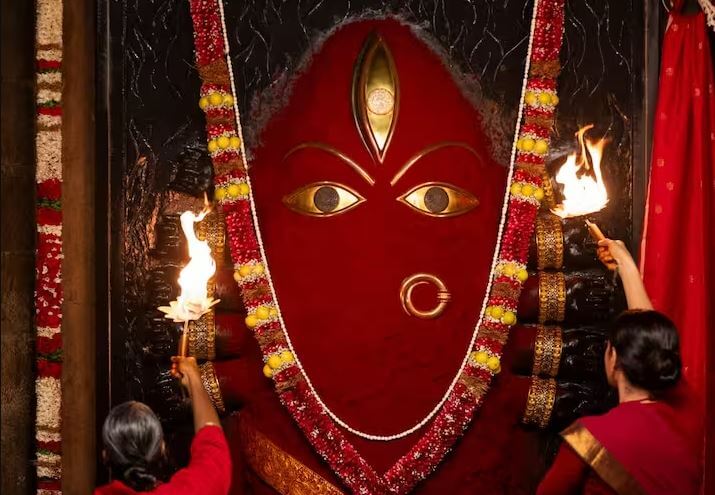
Bhairavi is a powerful goddess in Hinduism. The name Bhairavi translates to “terrible” or “fearsome”. Bhairavi is often seen as a form of Kali, the fierce aspect of Parvati. She is considered the consort of Bhairava, the fearsome form of Lord Shiva. Together, they represent the transformative power of creation and destruction.
Bhairavi is often depicted with a fierce expression, adorned with skulls and bones as ornaments. She is often depicted having three eyes, multiple arms holding weapons as well as a cup filled with blood (representing the cycle of life and death) and a crescent moon on her head. Her fearsome appearance signifies overcoming negativity and dissolving illusions. Her worship is believed to help devotees overcome fear, negativity, and internal demons. Another aspect of Bhairavi is Tripura Bhairavi also known as Kala Bhairavi, a powerful and multifaceted goddess symbolizing the conquest of the three worlds (waking, dreaming, and sleeping states) to achieve liberation. Tripura Bhairavi embodies the power to conquer limitations and transcend the illusionary world. She is a force for transformation, guiding devotees towards self-realization and liberation. Tripura Sundari and Tripura Bhairavi are closely associated but different.
Chhinnamasta – The Goddess of Transformation

Chhinnamasta also called Prachanda Chandika or Jogani Maa, is a fascinating and complex goddess in Hinduism. Her name translates to “the self-decapitated one”. She is typically depicted as a young, nude woman standing or seated on a copulating couple. She holds a scimitar in one hand and her severed head, in the other.
Chhinnamasta is described as being as red as the hibiscus flower. She is mostly depicted nude; however, her genitals are generally hidden by a multi-hooded cobra or jewellery. She is depicted as being young and slim. She is described as a sixteen-year-old girl with full breasts, adorned with lotuses or having a single blue lotus near her heart. The goddess carries her own severed head – sometimes on a platter or in a skull-bowl – in her left hand. Her two female companions are often depicted drinking the blood stream from her severed head.
Chhinnamasta symbolises both aspects of Devi as a life-giver and a life-taker. She is also considered a symbol of sexual self-control and an embodiment of sexual energy. She represents death, temporality, and destruction as well as life, immortality, and recreation. The goddess conveys spiritual self-realization and the awakening of the kundalini – spiritual energy. The legends of Chhinnamasta emphasise her self-sacrifice – sometimes coupled with a maternal element – sexual dominance, and self-destructive fury.
There isn’t a single, definitive legend surrounding Chhinnamasta in Shaktism and Tantric traditions. Details about Chhinnamasta’s origin are scattered across various texts. Multiple stories offer different interpretations of her self-decapitation. One narrative portrays her self-decapitation as an act of immense generosity. She severs her own head to offer her life force and blood to her companions, symbolizing the ultimate sacrifice for the well-being of others. Another story describes her self-decapitation as a display of fierce power. By severing her own head, she demonstrates her dominion over life and death.
Her self-decapitation symbolizes ultimate self-sacrifice and the overcoming of ego. The bloodletting symbolizes the continuous cycle of life and death, with Chhinnamasta as the source of both. Though Chhinnamasta is one of the Mahavidyas, there are very few temples devoted to her and her public worship is rare. However, she is a well-known Tantric deity, and worshipped by Tantric practitioners. Chhinnamasta is closely related to Chinnamunda – the severed-headed form of the Tibetan Buddhist goddess Vajrayogini.
Also Read: Tallest Shiva statues in the world
Dhumavati – The Goddess of Death and Decay
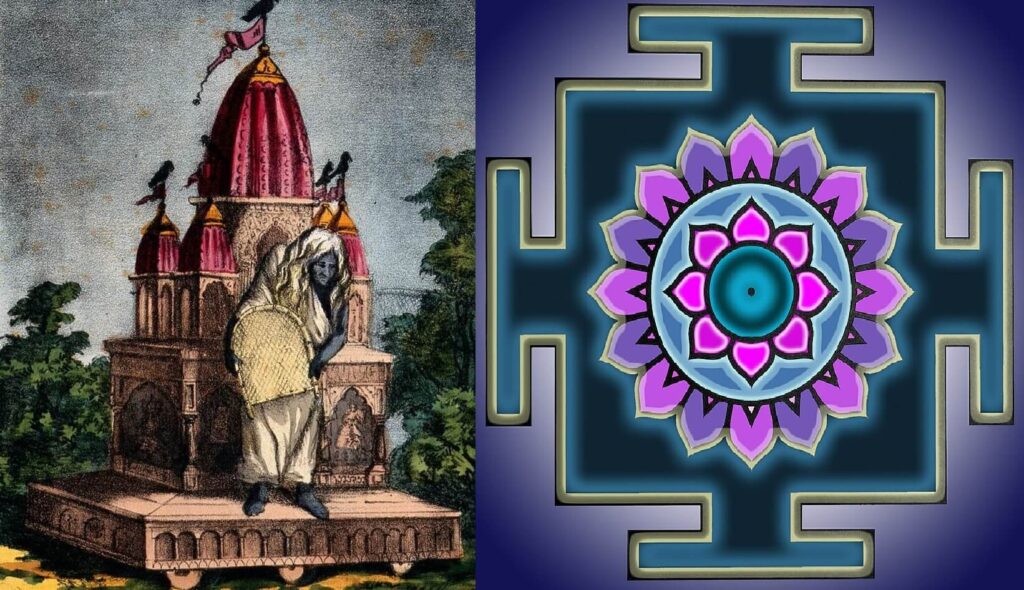
Dhumavati is a mysterious goddess among the ten Mahavidyas. Dhumavati is often portrayed as an old, widowed woman, with wrinkled face, gray hair, and shrunken figure. She wears worn-out clothes and lacks physical beauty. She is often depicted riding in a horseless chariot or on a crow, symbolizing her inauspicious nature. In some depictions, she carries a winnowing basket, a symbol of winnowing away negativity.
Dhumavati embodies the inauspicious, the darkness, and the things considered unattractive in Hinduism. While Dhumavati embodies negativity and inauspiciousness, her worship is believed to help devotees confront and overcome these aspects within themselves. Her aged appearance symbolizes detachment from worldly desires and the wisdom gained through experience.
Dhumavati’s meaning is multifaceted. She represents the impermanence of the world, the necessity of transformation, and the power to integrate and overcome negativity. Her worship is a path towards self-awareness, and detachment.
Dhumavati is not as widely worshipped as the other Mahavidyas. Her worship is practiced by those seeking to:
- Overcome negativity and inauspicious influences.
- Gain detachment from worldly attachments.
- Embrace wisdom and knowledge gained through life’s experiences.
Her worship practices are mainly within Tantric traditions and involve mantras, visualizations, and rituals.
Details about Dhumavati’s origins are scarce. Some narratives associate her with the destruction aspect of the divine feminine. In some Tantric texts, she is described as existing before creation, in the void from which the universe emerges.
One narrative describes Dhumavati appearing from the smoke of Shiva’s wife, Sati’s pyre. Dhumavati’s emerged from the smoke symbolizes the transformative power that arises from destruction and loss after Sati immolated herself due to her father’s insult to Shiva. Another narrative associates Dhumavati with the battle between Durga, the warrior goddess, and the demons Shumbha and Nishumbha. According to this story Dhumavati emerged from the smoke and ash created during the battle.
Bagalamukhi – The Goddess who controls speech and enemies
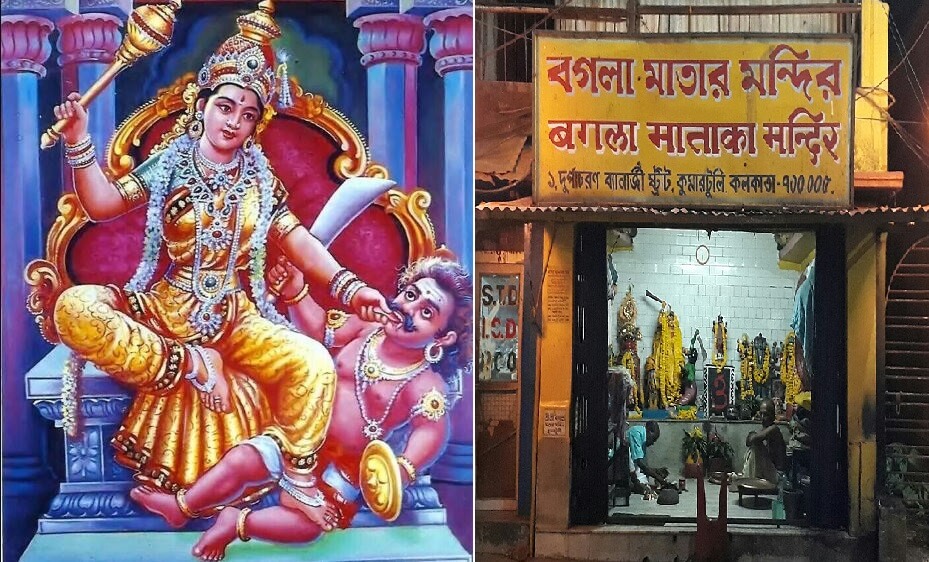
Bagalamukhi, also known as Pitambari, Shatrubuddhivinashini and Brahmastra Roopini is a fascinating goddess within Shaktism. The name Bagalamukhi translates to “bridle” or “the one who controls.” She represents the power to restrain, control, overcome negativity and dominate one’s enemies. It is believed that she turns each thing into its opposite.
Bagalamukhi is often depicted as a beautiful woman, dressed in yellow attire, sitting sits on a golden throne decorated with jewels. She has three eyes and two, four, or eight arms and a yellow crescent moon on her forehead. She is worshipped for:
- Victory in legal battles and disputes.
- Overcoming obstacles and challenges.
- Silencing enemies and negative influences.
- Gaining control over difficult situations.
The Vedas mention a goddess named Pitambari (another name for Bagalamukhi) who is worshipped by Lord Shiva himself. This suggests her antiquity and importance. Another narrative describes Bagalamukhi as emerging from the yellow spark of Durga’s rage during a battle. This association connects her to Durga’s fierce power and control over negativity.
A lesser-known story describes a situation where the gods were threatened by a powerful demon. Bagalamukhi emerged and used her power to paralyze the demon’s tongue, rendering him powerless. This story emphasizes her ability to silence negativity and control enemies.
- Her yellow attire represents control and dominion.
- Pulling a demon’s tongue symbolizes silencing negativity.
- Her club signifies overcoming challenges.
Matangi – The Goddess of outcasts and marginalized communities
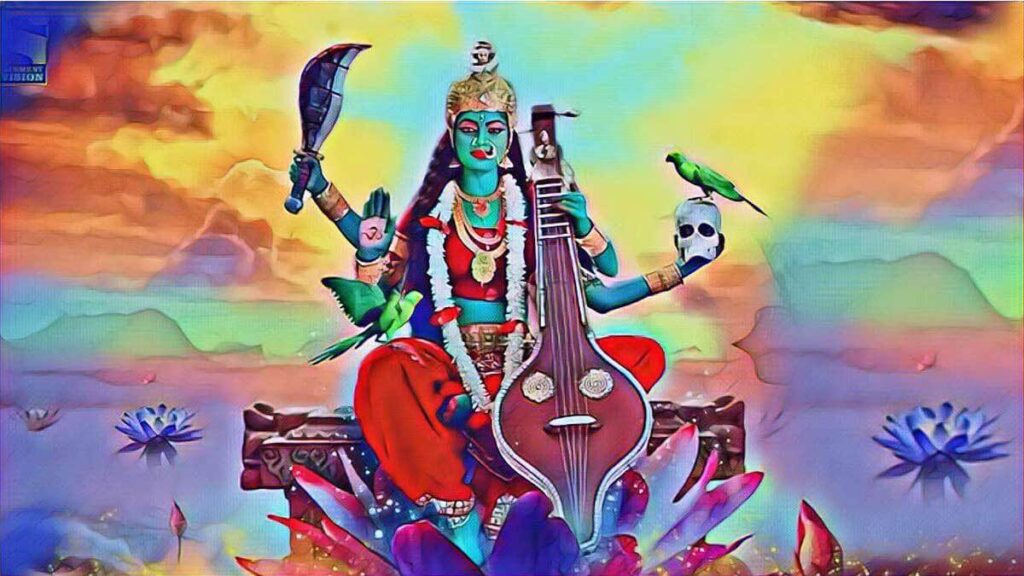
Matangi the ninth Mahavidya is a fascinating goddess in Hinduism. She represents the power of domination and the ability to attract and influence others. She is regarded as the Tantric form of Saraswati the goddess of music and learning. Matangi is considered to be the origin of Sarasvati. Matangi governs speech, music, knowledge and the arts. Her worship is prescribed to acquire supernatural powers, especially gaining control over enemies, attracting people to oneself, acquiring mastery over the arts and gaining supreme knowledge. Both embody music and are depicted playing the veena. Like Saraswati, Matangi represents knowledge, especially the traditional or orthodox forms of learning. However, Matangi goes beyond conventional knowledge. She is also associated with unconventional and even transgressive forms of wisdom, including those found in Tantric traditions.
Matangi is often depicted as emerald green in complexion, symbolizing her vibrancy and connection to unconventional knowledge. She is typically portrayed with four arms, holding various symbolic items like a noose, sword, goad, and a skull cup (kapala). Matangi is often shown wearing simple clothes, and adorned with bone ornaments. This links her to the fringes of society and unconventional paths to wisdom. Each item she holds (noose, sword, goad, skull cup) carries specific meanings related to control, discrimination, and attaining hidden knowledge.
Matangi is described as an outcaste (Chandalini) and offered left-over or partially eaten food (Uchchhishta) with unwashed hands or food after eating, both of which are considered to be impure in classical Hinduism.
Her significance lies more in her symbolic representation and worship within Tantric traditions. She is associated with acquiring supernatural powers, especially:
- Gaining control over enemies.
- Attracting others.
- Mastering the arts.
- Achieving supreme knowledge.
There isn’t a single, universally accepted legend about Matangi’s origin. One story describes Matangi arising from the dirt Sati (Shiva’s wife) brushed off her body during a fit of rage. Another story describes her as the daughter of a sage named Matanga, who belonged to the outcast Chandal caste. This association links Matangi to marginalized communities and unconventional wisdom.
Kamala – The Goddess of Wealth and Prosperity

Kamala, also known as Kamalatmika or Kamalalaya, is considered the Tantric aspect of Lakshmi, the goddess of prosperity, wealth, and auspiciousness. She is believed to be the last Mahavidya as well as the last form of the goddess Adi Parashakti. While Lakshmi is often associated with material abundance, Kamala the tenth Mahavidya represents a deeper spiritual abundance and fulfillment.
Like Lakshmi, Kamala is also depicted seated on a lotus flower, symbolizing purity, spiritual growth, and detachment from worldly concerns. She typically has four arms, signifying her multifaceted nature. Two of her hands hold lotuses, representing beauty and prosperity. The other two hands are held in gestures of granting blessings (varada mudra) and dispelling fear (abhaya mudra). She is often flanked by four white elephants, symbolizing abundance, power, and the fulfillment of desires.
While Lakshmi represents material prosperity, Kamala signifies the spiritual fulfillment and abundance that comes from inner peace and detachment. Her worship is believed to bestow blessings for:
- Spiritual growth and liberation (moksha).
- Inner peace and well-being.
- Overcoming greed and material attachments.
Some narratives describe her as emerging from a lotus flower, further emphasizing her connection to purity and spiritual abundance. In contrast to Lakshmi, who is often portrayed as a loving wife to Vishnu, Kamala is depicted as more independent, focusing on her role as the bestower of spiritual abundance. Some narratives describe Kamala as emerging from a lotus flower, a symbol of purity, spiritual growth, and detachment from worldly concerns.

